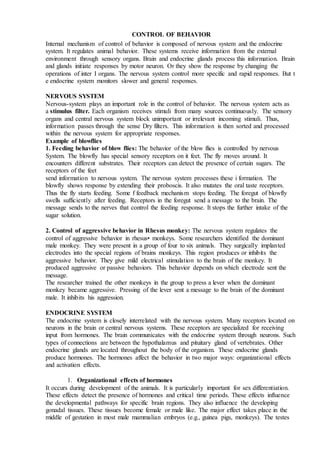
5. CONTROL OF BEHAVIOR.docx
- 1. CONTROL OF BEHAVIOR Internal mechanism of control of behavior is composed of nervous system and the endocrine system. It regulates animal behavior. These systems receive information from the external environment through sensory organs. Brain and endocrine glands process this information. Brain and glands initiate responses by motor neuron. Or they show the response by changing the operations of inter I organs. The nervous system control more specific and rapid responses. But t e endocrine system monitors slower and general responses. NERVOUS SYSTEM Nervous-system plays an important role in the control of behavior. The nervous system acts as a stimulus filter. Each organism receives stimuli from many sources continuously. The sensory organs and central nervous system block unimportant or irrelevant incoming stimuli. Thus, information passes through the sense Dry filters. This information is then sorted and processed within the nervous system for appropriate responses. Example of blowflies 1. Feeding behavior of blow flies: The behavior of the blow flies is controlled by nervous System. The blowfly has special sensory receptors on it feet. The fly moves around. It encounters different substrates. Their receptors can detect the presence of certain sugars. The receptors of the feet send information to nervous system. The nervous system processes these i formation. The blowfly shows response by extending their proboscis. It also mutates the oral taste receptors. Thus the fly starts feeding. Some f feedback mechanism stops feeding. The foregut of blowfly swells sufficiently after feeding. Receptors in the foregut send a message to the brain. The message sends to the nerves that control the feeding response. It stops the further intake of the sugar solution. 2. Control of aggressive behavior in Rhesus monkey: The nervous system regulates the control of aggressive behavior in rhesus• monkeys. Some researchers identified the dominant male monkey. They were present in a group of four to six animals. They surgically implanted electrodes into the special regions of brains monkeys. This region produces or inhibits the aggressive behavior. They give mild electrical stimulation to the brain of the monkey. It produced aggressive or passive behaviors. This behavior depends on which electrode sent the message. The researcher trained the other monkeys in the group to press a lever when the dominant monkey became aggressive. Pressing of the lever sent a message to the brain of the dominant male. It inhibits his aggression. ENDOCRINE SYSTEM The endocrine system is closely interrelated with the nervous system. Many receptors located on neurons in the brain or central nervous systems. These receptors are specialized for receiving input from hormones. The brain communicates with the endocrine system through neurons. Such types of connections are between the hypothalamus and pituitary gland of vertebrates. Other endocrine glands are located throughout the body of the organism. These endocrine glands produce hormones. The hormones affect the behavior in two major ways: organizational effects and activation effects. 1. Organizational effects of hormones It occurs during. development of the animals. It is particularly important for sex differentiation. These effects detect the presence of hormones and critical time periods. These effects influence the developmental pathways for specific brain regions. They also influence the developing gonadal tissues. These tissues become female or male like. The major effect takes place in the middle of gestation in most male mammalian embryos (e.g., guinea pigs, monkeys). The testes
- 2. produce a large amount of male hormone (testosterone). This organizes other developing tissues and certain regions of the brain. The female embryos develop in the absence of testosterone. Thus female like characteristics develop in the external anatomy and brain. These brain regions are important for sex differentiation. Genes normally turn on the production and release of testosterone. But sometimes, the testosterone comes from an external source. • Sometimes, cattle develop twin in the uterus. One member of the twin is male and other is female. A male fetus masculinized a female fetus. The system of male fetus turns on and releases testosterone during gestation. Some of that hormone crosses over and affect the developing female fetus. It produces a freemartin. It is a sterile heifer (offspring of cow). It shows a number of males like behavior patterns. Some pregnant human females are in danger of losing their fetus. They are given, some hormone treatments. This hormone is converted and acts like testosterone within the embryo. Thus, it causes masculinization of female embryos. 2. Activation effects of hormones An external stimulus starts a hormonally mediated response. It is called activation effects of hormone. Many male fishes develop territory boundary. Sometimes, their territory is threatened. Therefore, these males change color patterns. This change of color pattern is stimulated by hormones. The color change is an indication of aggressive behavior to defend the territory. Many animals like domestic cats, roosters, and mice are castrated (removal of tie gonads). They lose their aggressive fighting ability. The gonads are the sauce of testosterone. It stimulates particular brain receptors to produce aggression.